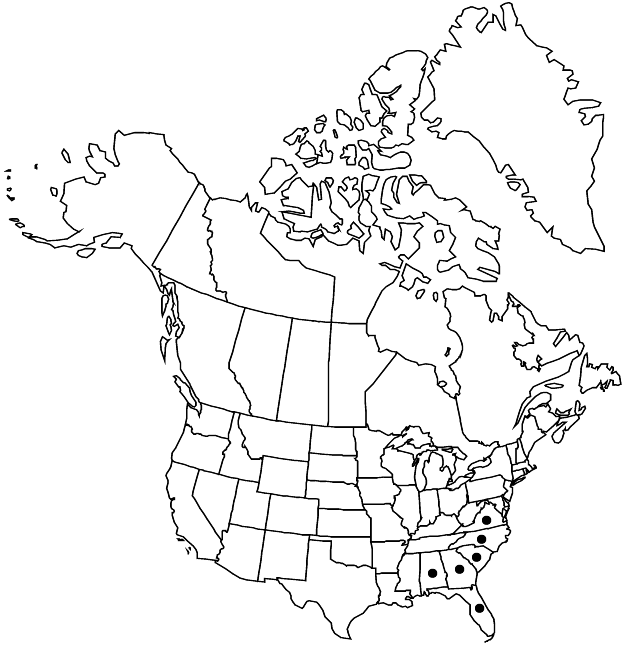Difference between revisions of "Paronychia baldwinii"
Repert. Bot. Syst. 1: 262. 1842.
FNA>Volume Importer |
imported>Volume Importer |
||
| (2 intermediate revisions by one other user not shown) | |||
| Line 8: | Line 8: | ||
}} | }} | ||
|common_names=Baldwin’s nailwort | |common_names=Baldwin’s nailwort | ||
| + | |special_status={{Treatment/ID/Special_status | ||
| + | |code=E | ||
| + | |label=Endemic | ||
| + | }} | ||
|basionyms={{Treatment/ID/Basionym | |basionyms={{Treatment/ID/Basionym | ||
|name=Anychia baldwinii | |name=Anychia baldwinii | ||
|authority=Torrey & A. Gray | |authority=Torrey & A. Gray | ||
| + | |rank=species | ||
|publication_title=Fl. N. Amer. | |publication_title=Fl. N. Amer. | ||
|publication_place=1: 172. 1838 | |publication_place=1: 172. 1838 | ||
| Line 17: | Line 22: | ||
|name=Anychiasatrum baldwinii | |name=Anychiasatrum baldwinii | ||
|authority=(Torrey & A. Gray) Small | |authority=(Torrey & A. Gray) Small | ||
| + | |rank=species | ||
}} {{Treatment/ID/Synonym | }} {{Treatment/ID/Synonym | ||
|name=Anychiasatrum riparium | |name=Anychiasatrum riparium | ||
|authority=(Chapman) Small | |authority=(Chapman) Small | ||
| + | |rank=species | ||
}} {{Treatment/ID/Synonym | }} {{Treatment/ID/Synonym | ||
|name=Paronychia baldwinii var. ciliata | |name=Paronychia baldwinii var. ciliata | ||
|authority=Chaudhri | |authority=Chaudhri | ||
| + | |rank=variety | ||
}} {{Treatment/ID/Synonym | }} {{Treatment/ID/Synonym | ||
|name=Paronychia baldwinii subsp. riparia | |name=Paronychia baldwinii subsp. riparia | ||
|authority=(Chapman) Chaudhri | |authority=(Chapman) Chaudhri | ||
| + | |rank=subspecies | ||
}} {{Treatment/ID/Synonym | }} {{Treatment/ID/Synonym | ||
|name=Paronychia riparia | |name=Paronychia riparia | ||
| − | |authority= | + | |authority= |
| + | |rank=species | ||
}} | }} | ||
|hierarchy=Caryophyllaceae;Caryophyllaceae subfam. Paronychioideae;Paronychia;Paronychia baldwinii | |hierarchy=Caryophyllaceae;Caryophyllaceae subfam. Paronychioideae;Paronychia;Paronychia baldwinii | ||
| Line 53: | Line 63: | ||
-->{{#Taxon: | -->{{#Taxon: | ||
name=Paronychia baldwinii | name=Paronychia baldwinii | ||
| − | |||
|authority=(Torrey & A. Gray) Fenzl ex Walpers | |authority=(Torrey & A. Gray) Fenzl ex Walpers | ||
|rank=species | |rank=species | ||
| Line 67: | Line 76: | ||
|publication title=Repert. Bot. Syst. | |publication title=Repert. Bot. Syst. | ||
|publication year=1842 | |publication year=1842 | ||
| − | |special status= | + | |special status=Endemic |
| − | |source xml=https:// | + | |source xml=https://bitbucket.org/aafc-mbb/fna-data-curation/src/2e0870ddd59836b60bcf96646a41e87ea5a5943a/coarse_grained_fna_xml/V5/V5_56.xml |
|subfamily=Caryophyllaceae subfam. Paronychioideae | |subfamily=Caryophyllaceae subfam. Paronychioideae | ||
|genus=Paronychia | |genus=Paronychia | ||
Latest revision as of 22:12, 5 November 2020
Plants annual, biennial, or perennial, often matted; taproot slender. Stems prostrate to erect, branched, 5–70 cm, mostly retrorsely to spreading-pubescent on 1 side or throughout. Leaves: stipules lanceolate, 2–6 mm, apex acuminate, entire; blade oblong to elliptic or oblanceolate, 3–25 × 1–6 mm, herbaceous, apex acute and briefly cuspidate, glabrous. Cymes terminal, 20–40+-flowered, diffuse, lax, repeatedly forked or dichotomous. Flowers 5-merous, ± short-cylindric, with enlarged hypanthium and calyx cylindric, 1–1.7 mm, glabrous to pubescent with short hairs, often minutely ciliate, sometimes glaucous; sepals greenish or greenish white to brownish, veins absent, ovate to oblong, 0.8–1.3 mm, herbaceous, margins white, 0.05–0.1 mm wide, scarious to papery, apex terminated by minute cusp, hood narrowly rounded, cusp light green to whitish, straight, short-conic, 0.1–0.15 mm, minutely scabrous; staminodes subulate, 0.2–0.3 mm; style 1, cleft in distal 4/5+, 0.2–0.4 mm. Utricles ellipsoid, 1–1.3 mm, papillate distally.
Phenology: Flowering summer–fall.
Habitat: Dunes, woodlands, fields, clearings, roadsides, riverbanks, hummocks, waste places
Elevation: 0-200 m
Distribution

Ala., Fla., Ga., N.C., S.C., Va.
Discussion
Chaudhri used duration and pubescence to recognize two subspecies of Paronychia baldwinii, characters that L. H. Shinners (1962c) found to vary independently in this species.
Selected References
None.